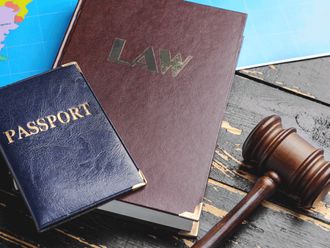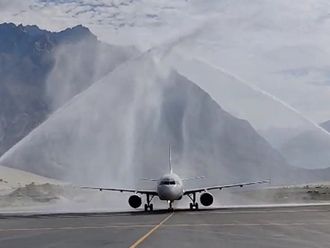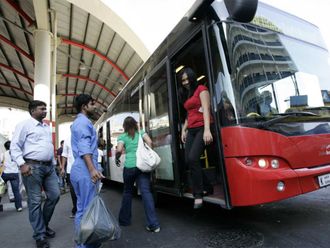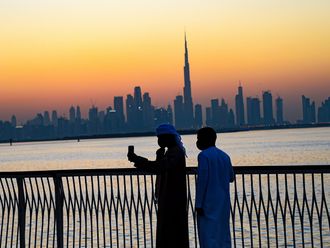The UAE sees at least 300 days of sunlight if not more, every year, making it one of the best places in the world to use non-polluting solar power. But only a fraction of that potential has been tapped. Friday looks at the ways by which solar energy could be used in this country and the difference it would make...
Every day at dusk, the shimmering streetlights on Sheikh Zayed Road illuminate the way home, the way to the Capital, and the sights and sounds of one of the most dynamic skylines in the region.
The cost involved in merely lighting up the highway goes into tens of thousands of dirhams daily, given the high-intensity lights used, the number of poles and the necessity for underground cabling to connect the entire chain. And that's not considering the light pollution and damaging emissions produced by generating electricity.
But what if all those highway lights were powered by the sun, using photovoltaic panels charged during the day as commuters sped past and expended during the evenings and nights as they speed past once more?
No expensive excavations and cabling, no maintenance, no emissions, and no pollution. And no need to keep footing an electricity bill - within years, the cost savings from the panels will pay for their purchase and installation costs. After that, the system is virtually free.
"It is possible," says Shariar Faghfoori, manager of Dubai-based Gulf Solar Technologies. "With some compromise and a great deal of awareness, there is no reason this could not be done. And at some point, it will need to be done."
Sunbelt
On average, the UAE receives more than 300 days of sunshine in a year, placing it squarely on the planet's sunbelt, a swath of high-solar activity that includes the American southwest, northern Africa, the subcontinent and Western Australia.
Many of these nations are already using solar power to great advantage: for street lighting in Australia, for rural power supply in remote areas of the Philippines, for solar cooking in India, and for sustaining homes and contributing to the national grid in the U.S.
The driving forces behind this change are varied: steep power charges, an increasing unwillingness to depend on foreign sources of energy, mounting eco-awareness and the cost-efficiency of solar power.
The abundant and clean solar power remains in its infancy here. Some of the most popular uses of it include the orange parking meters in Dubai, offshore buoys, Etisalat installations in remote areas, solar water heating systems employed by some hotels, and the occasional solar charger or other gadget purchased by green power enthusiasts.
There is a great deal more that could be done.
Around the world, there are three main ways to use solar: in passive, active and photovoltaic avenues. Passive solar, which has the largest impact on energy consumption and is the simplest to use, has been in use since the ancient Greek civilisation and can be seen in traditional Arab and even Native American cultures. It involves managing natural sunlight via orientation, design and structure to maintain desired temperatures within a building.
Active solar systems use collection and concentration systems to produce heat and energy. Solar water heaters and solar cookers, which can be used for everything from cooking dal (lentil) to pot roast, are based on this technology.
The third and fastest growing application of solar power is through photovoltaic (PV) cells and panels, which convert light into electricity. PV cells originated with the U.S. space programme, but are now used everywhere - from calculators and watches to power systems for yachts and large rural power supplies. In an increasingly high-tech and high-rise world, PV has the additional advantage of being easily integrated in building design.
Each of the three forms can be utilised in the UAE.
Passive solar design has long been a mainstay in Arab countries, where thick walls kept temperatures moderate, tree-lined courtyards provided shade and barjeels (wind towers) circulated cool air into rooms. In modern mass-accommodation apartment buildings and Western-style skyscrapers and luxury homes, however, these age-old principles have often fallen by the wayside, creating relatively inefficient buildings that place severe loads on cooling and electricity systems.
One of the main drawbacks of solar power is its limited yield per cell: the more electricity needed, the more space a PV system would need to produce it. In high-consumption and warmer countries like the UAE, the best way to use the sun's strength is to reduce consumption so that solar power can be viable.
A price on clean energy Dubai Municipality's recent campaign to promote thermal insulation is one indication that the country is moving forward on this score. By ensuring that apartments and even buildings are well insulated either before or after construction, municipality officials say, everyone benefits - effective insulation can reduce electricity bills by 40 per cent, will reduce the burden on local and Federal electricity and water authorities, and will result in cleaner air for all.
Cost-consciousness has also forced energy-efficient mindsets in the contemporary construction and contracting industry. The architects of Burj Al Arab, for example, ensured that the land-facing side of the sailboat-shaped building was not sheathed in glass as the sea-facing side is, as the resultant heat gain would have been a tremendous and unjustifiable expenditure.
Says Shariar Faghfoori of Gulf Solar Technologies, "In Europe, people have compromised to take 60W of light rather than a 100W, to take a few hundred rather than 4000W in their street lights. It's not that they are suffering - they have standard lighting, but they don't have more than what they really need. Overlighting does not make a practical difference, it doesn't help you see better, it just means there's more light."
Faghfoori and his family's group of companies have been involved with a variety of solar power-projects around the region. In Saudi Arabia, solar power has been used for oilfield lighting systems, cathodic protection for pipelines, advertising signage and traffic signalling. In Iran, it has been used for lighting public parks, streets and even to power a water pump to provide water to 700 people in a remote village - a system that worked even in the snowy winter.
Dr. Alan Dickson, manager of one of the first solar power organisations in the UAE, makes a strong case for efficiency in both large-scale commercial buildings as well as individual consumer items like computer monitors. A building that replaced its 2,000 60-watt tungsten light bulbs in bathrooms, stairwells and lift shafts with longer-lasting, lower-output compact fluorescent tubes saved thousands on labour costs, electricity bills and emissions. Similarly, the slim National Laboratories computer screens require far less energy than the old CRT monitors, ensuring that the money saved makes up for the additional cost of the newer technology.
Even though solar energy can be an exceptionally reliable source of power in this area, according to Dickson, managing partner for Solstice International, it has to be coupled with energy efficiency to truly make a
Harnessing solar energy
The UAE sees at least 300 days of sunlight if not more, every year, making it one of the best places in the world to use non-polluting solar power. But only a fraction of that potential has been tapped.










